Shelf-Life Extension and Quality Changes of Fresh-Cut Apple via Sago and Soy-Oil-Based Edible Coatings
Abstract
1. Introduction
2. Materials and Methods
2.1. Materials
2.2. Methods
2.2.1. Preparation of Coating Solutions
2.2.2. Apple Processing and Application of Coating
2.3. Physicochemical Analysis
2.3.1. pH
2.3.2. Total Soluble Solids (TSSs)
2.3.3. Non-Enzymatic Browning Index (NEBI)
2.3.4. Moisture Content
2.3.5. Weight Loss
2.3.6. Headspace Analysis
2.3.7. Color Analysis
2.4. Sensory Analysis
2.5. Microbial Analysis
2.6. Statistical Analysis
3. Results and Discussion
3.1. pH
3.2. Total Soluble Solids (TSSs)
3.3. Non-Enzymatic Browning Index
3.4. Moisture Content
3.5. Weight Loss
3.6. Headspace Analysis
3.7. Browning Index (BI) and Whiteness Index (WI)
3.8. Sensory Analysis
3.9. Microbial Analysis
4. Conclusions
Author Contributions
Funding
Institutional Review Board Statement
Informed Consent Statement
Data Availability Statement
Conflicts of Interest
References
- Slavin, J.L.; Lloyd, B. Health Benefits of Fruits and Vegetables. Adv. Nutr. 2012, 3, 506–516. [Google Scholar] [CrossRef] [PubMed]
- Chiabrando, V.; Giacalone, G. Effect of Antibrowning Agents on Color and Related Enzymes in Fresh-Cut Apples During Cold Storage. J. Food Process. Preserv. 2012, 36, 133–140. [Google Scholar] [CrossRef][Green Version]
- Olivas, G.I.; Barbosa-Cánovas, G.V. Edible Coatings for Fresh-Cut Fruits. Crit. Rev. Food Sci. Nutr. 2005, 45, 657–670. [Google Scholar] [CrossRef] [PubMed]
- Yousuf, O.; Singh, A. An innovative approach of development of edible coating for fresh cut apple fruit for value addition of horticultural produce. J. Pharmacogn. Phytochem. 2018, 7, 2353–2355. [Google Scholar]
- Cortellino, G.; Gobbi, S.; Bianchi, G.; Rizzolo, A. Modified atmosphere packaging for shelf life extension of fresh-cut apples. Trends Food Sci. Technol. 2015, 46 Pt B, 320–330. [Google Scholar] [CrossRef]
- Graça, A.; Santo, D.; Esteves, E.; Nunes, C.; Abadias, M.; Quintas, C. Evaluation of microbial quality and yeast diversity in fresh-cut apple. Food Microbiol. 2015, 51, 179–185. [Google Scholar] [CrossRef]
- Kumar, P.; Sethi, S.; Sharma, R.R.; Singh, S.; Varghese, E. Improving the shelf life of fresh-cut “Royal Delicious” apple with edible coatings and anti-browning agents. J. Food Sci. Technol. 2018, 55, 3767–3778. [Google Scholar] [CrossRef]
- Rux, G.; Bohne, K.; Huyskens-Keil, S.; Ulrichs Ch Hassenberg, K.; Herppich, W.B. Effects of modified atmosphere and sugar immersion on physiology and quality of fresh-cut “Braeburn” apples. Food Packag. Shelf Life 2021, 29, 100726. [Google Scholar] [CrossRef]
- Popović, S.Z.; Lazić, V.L.; Hromiš, N.M.; Šuput, D.Z.; Bulut, S.N. Chapter 8—Biopolymer Packaging Materials for Food Shelf-Life Prolongation. In Biopolymers for Food Design; Grumezescu, A.M., Holban, A.M., Eds.; Academic Press: Cambridge, MA, USA, 2018; pp. 223–277. [Google Scholar] [CrossRef]
- Oduro, K.O.-A. Edible Coating. In Postharvest Technology; Ahiduzzaman, M., Ed.; IntechOpen: London, UK, 2021. [Google Scholar] [CrossRef]
- Sultan, M.; Hafez, O.M.; Saleh, M.A.; Youssef, A.M. Smart edible coating films based on chitosan and beeswax–pollen grains for the postharvest preservation of Le Conte pear. RSC Adv. 2021, 11, 9572–9585. [Google Scholar] [CrossRef]
- Sapper, M.; Chiralt, A. Starch-based coatings for preservation of fruits and vegetables. Coatings 2018, 8, 152. [Google Scholar] [CrossRef]
- Sánchez-Ortega, I.; García-Almendárez, B.E.; Santos-López, E.M.; Amaro-Reyes, A.; Barboza-Corona, J.E.; Regalado, C. Antimicrobial Edible Films and Coatings for Meat and Meat Products Preservation. Sci. World J. 2014, 248935. [Google Scholar] [CrossRef] [PubMed]
- Luo, Z.; Li, D.; Xie, J.; Feng, S.; Wang, Y. Effects of Heat Treatment on Quality and Browning of Fresh-Cut Sugarcane. J. Food Process. Preserv. 2015, 39, 688–696. [Google Scholar] [CrossRef]
- Qadri, O.S.; Yousuf, B.; Srivastava, A.K. Fresh-cut fruits and vegetables: Critical factors influencing microbiology and novel approaches to prevent microbial risks—A review. Cogent Food Agric. 2015, 1, 1121606. [Google Scholar] [CrossRef]
- Ahmad, A.; Dubey, P.; Younis, K.; Yousuf, O. Mosambi (Citrus limetta) peel and Sago based biodegradable film: Development and characterization of physical, water barrier and biodegradation properties. Bioresour. Technol. Rep. 2022, 18, 101016. [Google Scholar] [CrossRef]
- Kasim, R.; Bintoro, N.; Rahayoe, S.; Pranoto, Y. Physiological activity of banana coated with sago starch and cellulose nanofiber edible coating. In Proceedings of the IOP Conference Series: Earth and Environmental Science, Surakarta, Indonesia, 24–25 August 2021; Volume 653, p. 012019. [Google Scholar] [CrossRef]
- Mali, S.; Grossmann, M.V.E.; García, M.A.; Martino, M.N.; Zaritzky, N.E. Mechanical and thermal properties of yam starch films. Food Hydrocoll. 2005, 19, 157–164. [Google Scholar] [CrossRef]
- Polnaya, F.; Talahatu, J.; Haryadi, H.; Marseno, D. Properties of biodegradable films from hydroxypropyl sago starches. Asian J. Food Agro-Ind. 2012, 5, 183–192. [Google Scholar]
- Jiang, Y.; Duan, X.; Qu, H.; Zheng, S. Browning: Enzymatic Browning. In Encyclopedia of Food and Health; Caballero, B., Finglas, P.M., Toldrá, F., Eds.; Academic Press: Cambridge, MA, USA, 2016; pp. 508–514. [Google Scholar] [CrossRef]
- AOAC. Official Methods of Analysis: Association of Official Analytical Chemists, 18th ed.; Association of Official Analytical Chemists: Gaithersburgs, MD, USA, 2006. [Google Scholar]
- Dong, H.; Cheng, L.; Tan, J.; Zheng, K.; Jiang, Y. Effects of chitosan coating on quality and shelf life of peeled litchi fruit. J. Food Eng. 2004, 64, 355–358. [Google Scholar] [CrossRef]
- Rattanathanalerk, M.; Chiewchan, N.; Srichumpoung, W. Effect of thermal processing on the quality los of pineapple juice. J. Food Eng. 2005, 66, 259–265. [Google Scholar] [CrossRef]
- Zhu, D.; Ji, B.; Eum, H.L.; Zude, M. Evaluation of the non-enzymatic browning in thermally processed apple juice by front-face fluorescence spectroscopy. Food Chem. 2009, 113, 272–279. [Google Scholar] [CrossRef]
- Hosseini, M.S.; Zahedi, S.M.; Abadía, J.; Karimi, M. Effects of postharvest treatments with chitosan and putrescine to maintain quality and extend shelf-life of two banana cultivars. Food Sci. Nutr. 2018, 6, 1328–1337. [Google Scholar] [CrossRef]
- Yousuf, B.; Srivastava, A. Psyllium (Plantago) Gum as an Effective Edible Coating to Improve Quality and Shelf Life of Fresh-cut Papaya (Carica papaya). Int. J. Biol. Biomol. Agric. Food Biotechnol. Eng. 2015, 9, 702–707. [Google Scholar]
- Waghmare, R.; Annapure, U. Combined effect of chemical treatment and/or modified atmosphere packaging (MAP) on quality of fresh-cut papaya. Postharvest Biol. Technol. 2013, 85, 147–153. [Google Scholar] [CrossRef]
- Olivas, G.I.; Mattinson, D.S.; Barbosa-Cánovas, G.V. Alginate coatings for preservation of minimally processed ‘Gala’ apples. Postharvest Biol. Technol. 2007, 45, 89–96. [Google Scholar] [CrossRef]
- Prakash, A.; Baskaran, R.; Vadivel, V. Citral nanoemulsion incorporated edible coating to extend the shelf life of fresh cut pineapples. LWT 2020, 118, 108851. [Google Scholar] [CrossRef]
- Charles Oluwaseun, A.; Kayode, A.; Oluyemisi Bolajoko, F.; Bunmi, A.J.; Ar, O. Effect of edible coatings of carboxy methyl cellulose and corn starch on cucumber stored at ambient temperature. Asian J. Agric. Biol. 2013, 1, 133–140. [Google Scholar]
- Yousuf, B.; Srivastava, A.K. Impact of honey treatments and soy protein isolate-based coating on fresh-cut pineapple during storage at 4 °C. Food Packag. Shelf Life 2019, 21, 100361. [Google Scholar] [CrossRef]
- Jiang, T.; Duan, Q.; Zhu, J.; Liu, H.; Yu, L. Starch-based biodegradable materials: Challenges and opportunities. Adv. Ind. Eng. Polym. Res. 2020, 3, 8–18. [Google Scholar] [CrossRef]
- Ortega-Toro, R.; Collazo-Bigliardi, S.; Talens, P.; Chiralt, A. Thermoplastic starch: Improving their barrier properties. Agron. Colomb. 2016, 34, S73. [Google Scholar]
- Noiwan, D.; Sutenan, K.; Yodweingchai, C.; Rachtanapun, P. Postharvest Life Extension of Fresh-Cut Mango (Mangifera indica cv. Fa-Lun) Using Chitosan and Carboxymethyl Chitosan Coating. J. Agric. Sci. 2018, 10, 438. [Google Scholar] [CrossRef]
- Sharma, M.; Saini, C.S. Postharvest shelf-life extension of fresh-cut guavas (Psidium guajava) using flaxseed protein-based composite coatings. Food Hydrocoll. Health 2021, 1, 100015. [Google Scholar] [CrossRef]
- Khalifa, I.; Barakat, H.; El-Mansy, H.A.; Soliman, S.A. Improving the shelf-life stability of apple and strawberry fruits applying chitosan-incorporated olive oil processing residues coating. Food Packag. Shelf Life 2016, 9, 10–19. [Google Scholar] [CrossRef]
- Versino, F.; Lopez, O.V.; Garcia, M.A.; Zaritzky, N.E. Starch-based films and food coatings: An overview. In Starch/Staerke; Wiley-VCH: Hoboken, NJ, USA, 2016; Volume 68, pp. 1026–1037. [Google Scholar] [CrossRef]
- Garcia, L.C.; Pereira, L.M.; De Luca Sarantópoulos CI, G.; Hubinger, M.D. Effect of antimicrobial starch edible coating on shelf-life of fresh strawberries. Packag. Technol. Sci. 2012, 25, 413–425. [Google Scholar] [CrossRef]
- Raghav, P.K.; Agarwal, N.; Saini, M. Edible Coating of Fruits and Vegetables: A Review. Int. J. Sci. Res. Mod. Educ. 2016, 1, 188–204. Available online: https://www.researchgate.net/publication/331298687 (accessed on 13 July 2024).
- Liyanapathiranage, A.; Dassanayake, R.S.; Gamage, A.; Rao Karri, R.; Manamperi, A.; Evon, P.; Jayakodi, Y.; Madhujith, T.; Merah, O. Recent Developments in Edible Films and Coatings for Fruits and Vegetables. Coatings 2023, 13, 1177. [Google Scholar] [CrossRef]
- Solís-Contreras, G.A.; Rodríguez-Guillermo, M.C.; de la Luz Reyes-Vega, M.; Aguilar, C.N.; Rebolloso-Padilla, O.N.; Corona-Flores, J.; de Abril Alexandra Soriano-Melgar, L.; Ruelas-Chacon, X. Extending shelf-life and quality of minimally processed golden delicious apples with three bioactive coatings combined with cinnamon essential oil. Foods 2021, 10, 597. [Google Scholar] [CrossRef] [PubMed]
- Mohamed AM, A.; Ramaswamy, H.S. Effect of Soybean Oil on the Improvement of the Functionality of Edible Membrane-Type Food Packaging Films Based on Caseinate–Carboxymethyl Chitosan Compositions. Membranes 2024, 14, 104. [Google Scholar] [CrossRef]
- Cofelice, M.; Lopez, F.; Cuomo, F. Quality Control of Fresh-Cut Apples after Coating Application. Foods 2019, 8, 189. [Google Scholar] [CrossRef]
- Viacava, G.E.; Cenci, M.P.; Ansorena, M.R. Effect of Chitosan Edible Coatings Incorporated with Free or Microencapsulated Thyme Essential Oil on Quality Characteristics of Fresh-Cut Carrot Slices. Food Bioprocess Technol. 2022, 15, 768–784. [Google Scholar] [CrossRef]
- Rojas-Graü, M.A.; Tapia, M.S.; Martín-Belloso, O. Using polysaccharide-based edible coatings to maintain quality of fresh-cut Fuji apples. Lwt—Food Sci. Technol. 2008, 41, 139–147. [Google Scholar] [CrossRef]
- Sousa, F.F.; Pinsetta Junior, J.S.; Oliveira, K.T.E.F.; Rodrigues, E.C.N.; Andrade, J.P.; Mattiuz, B.-H. Conservation of ‘Palmer’ mango with an edible coating of hydroxypropyl methylcellulose and beeswax. Food Chem. 2021, 346, 128925. [Google Scholar] [CrossRef]
- Martínez-Romero, D.; Alburquerque, N.; Valverde, J.M.; Guillén, F.; Castillo, S.; Valero, D.; Serrano, M. Postharvest sweet cherry quality and safety maintenance by Aloe vera treatment: A new edible coating. Postharvest Biol. Technol. 2006, 39, 93–100. [Google Scholar] [CrossRef]
- Ansah, F.A.; Amodio, M.L.; Colelli, G. Quality of fresh-cut products as affected by harvest and postharvest operations. J. Sci. Food Agric. 2018, 98, 3614–3626. [Google Scholar] [CrossRef] [PubMed]
- Oms-Oliu, G.; Soliva-Fortuny, R.; Martín-Belloso, O. Edible coatings with antibrowning agents to maintain sensory quality and antioxidant properties of fresh-cut pears. Postharvest Biol. Technol. 2008, 50, 87–94. [Google Scholar] [CrossRef]
- Al-Amrani, M.; Al-Alawi, A.; Al-Marhobi, I. Assessment of Enzymatic Browning and Evaluation of Antibrowning Methods on Dates. Int. J. Food Sci. 2020, 8380461. [Google Scholar] [CrossRef]
- Moon, K.M.; Kwon, E.-B.; Lee, B.; Kim, C.Y. Recent Trends in Controlling the Enzymatic Browning of Fruit and Vegetable Products. Molecules 2020, 25, 2754. [Google Scholar] [CrossRef]
- Fan, X. Chemical inhibition of polyphenol oxidase and cut surface browning of fresh-cut apples. Crit. Rev. Food Sci. Nutr. 2022, 63, 8737–8751. [Google Scholar] [CrossRef]
- Lee, J.Y.; Park, H.J.; Lee, C.Y.; Choi, W.Y. Extending shelf-life of minimally processed apples with edible coatings and antibrowning agents. LWT—Food Sci. Technol. 2003, 36, 323–329. [Google Scholar] [CrossRef]
- Perez-Gago, M.B.; Serra, M.; del Río, M.A. Color change of fresh-cut apples coated with whey protein concentrate-based edible coatings. Postharvest Biol. Technol. 2006, 39, 84–92. [Google Scholar] [CrossRef]
- Rocha, A.; de Morais, A.M.M.B. Shelf life of minimally processed apple (cv. Jonagored) determined by colour changes. Food Control 2003, 14, 13–20. [Google Scholar] [CrossRef]
- Zhao, Y.; McDaniel, M. Sensory quality of foods associated with edible film and coating systems and shelf-life extension. Innov. Food Packag. 2005, 434–453. [Google Scholar] [CrossRef]
- Bell, C. Institute of Food Science and Technology of the United Kingdom. Development and Use of Microbiological Criteria for Foods; IFST: London, UK, 1999. [Google Scholar]
- Tabassum, N.; Khan, M.A. Modified atmosphere packaging of fresh-cut papaya using alginate based edible coating: Quality evaluation and shelf life study. Sci. Hortic. 2020, 259, 108853. [Google Scholar] [CrossRef]
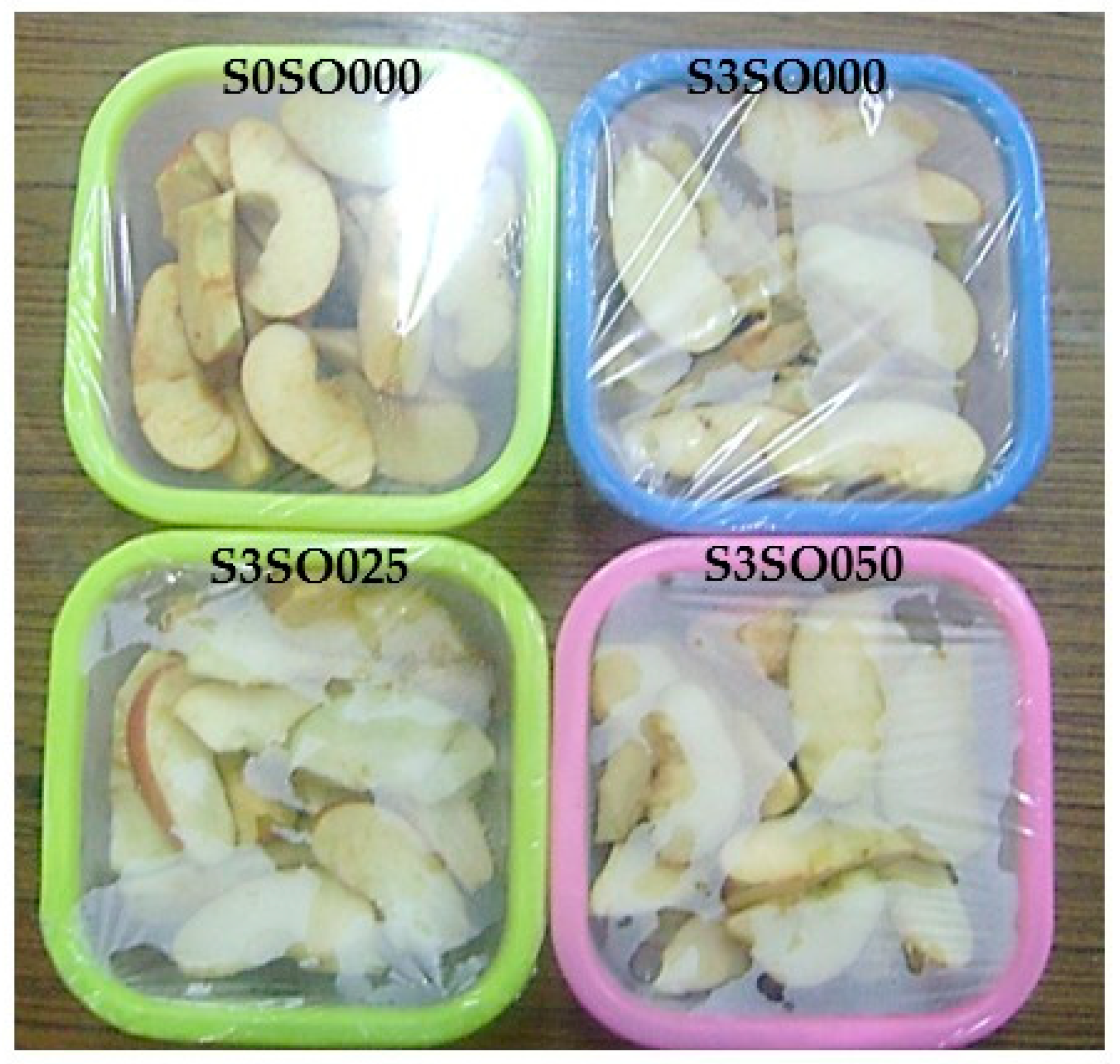
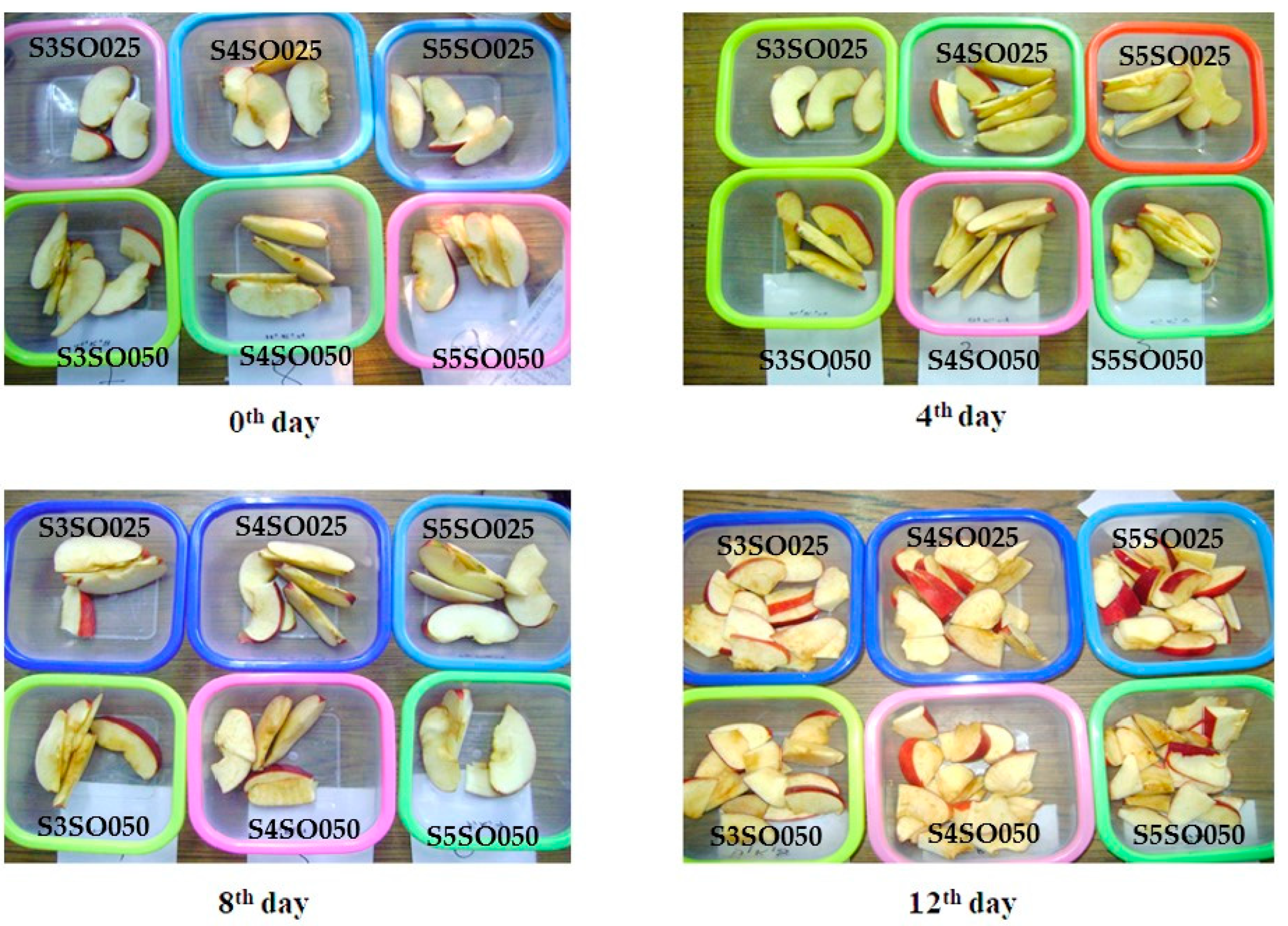
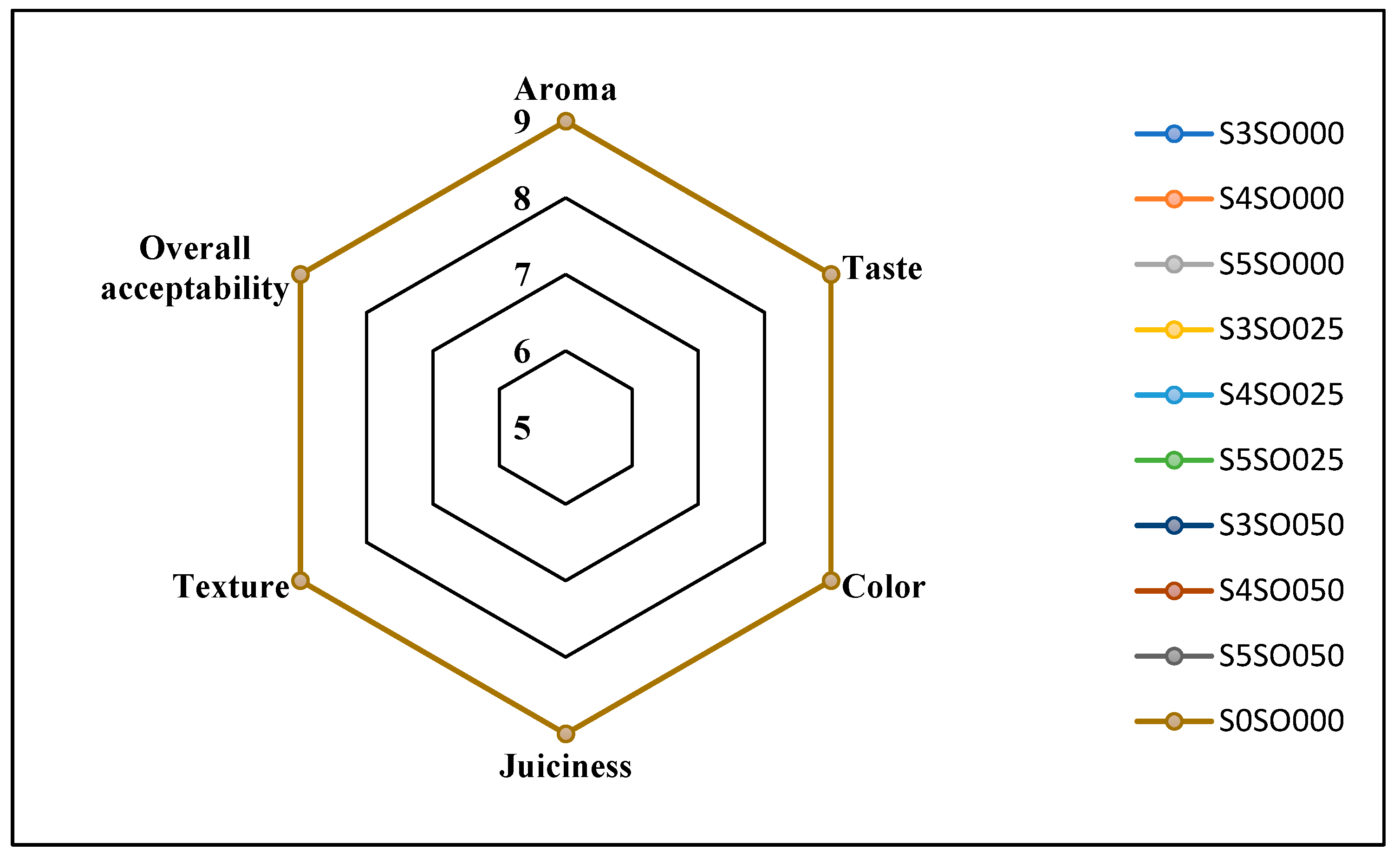
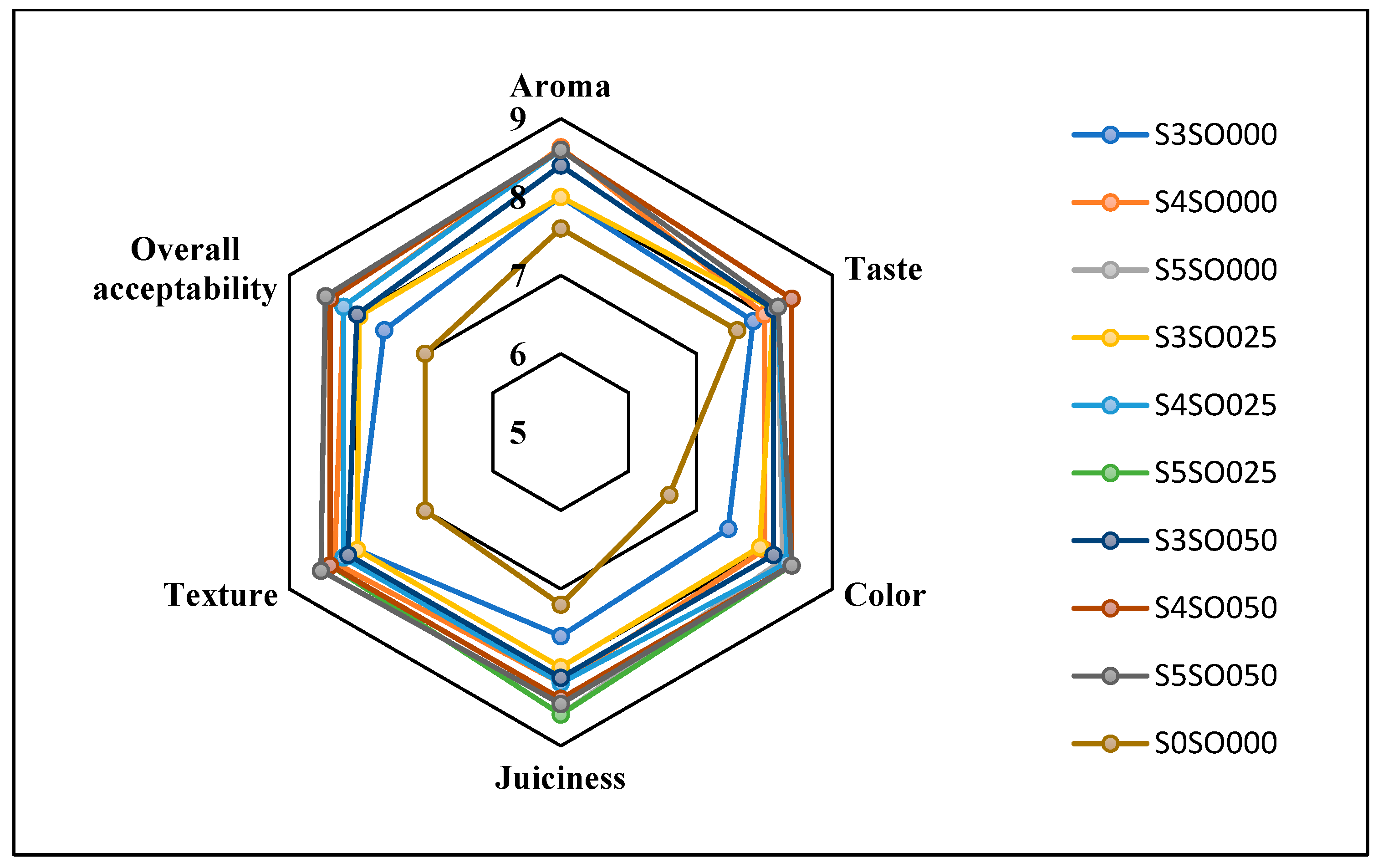
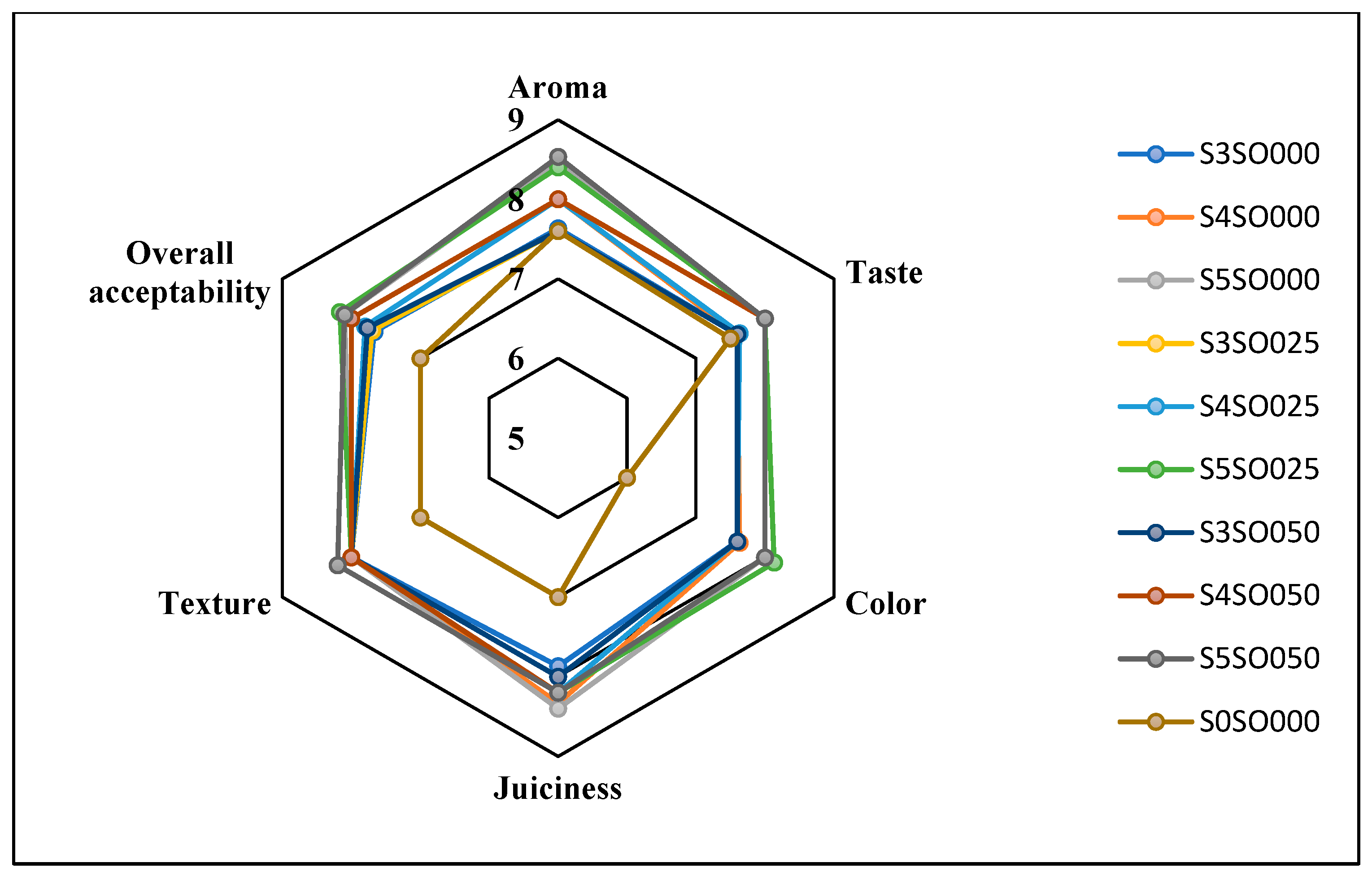
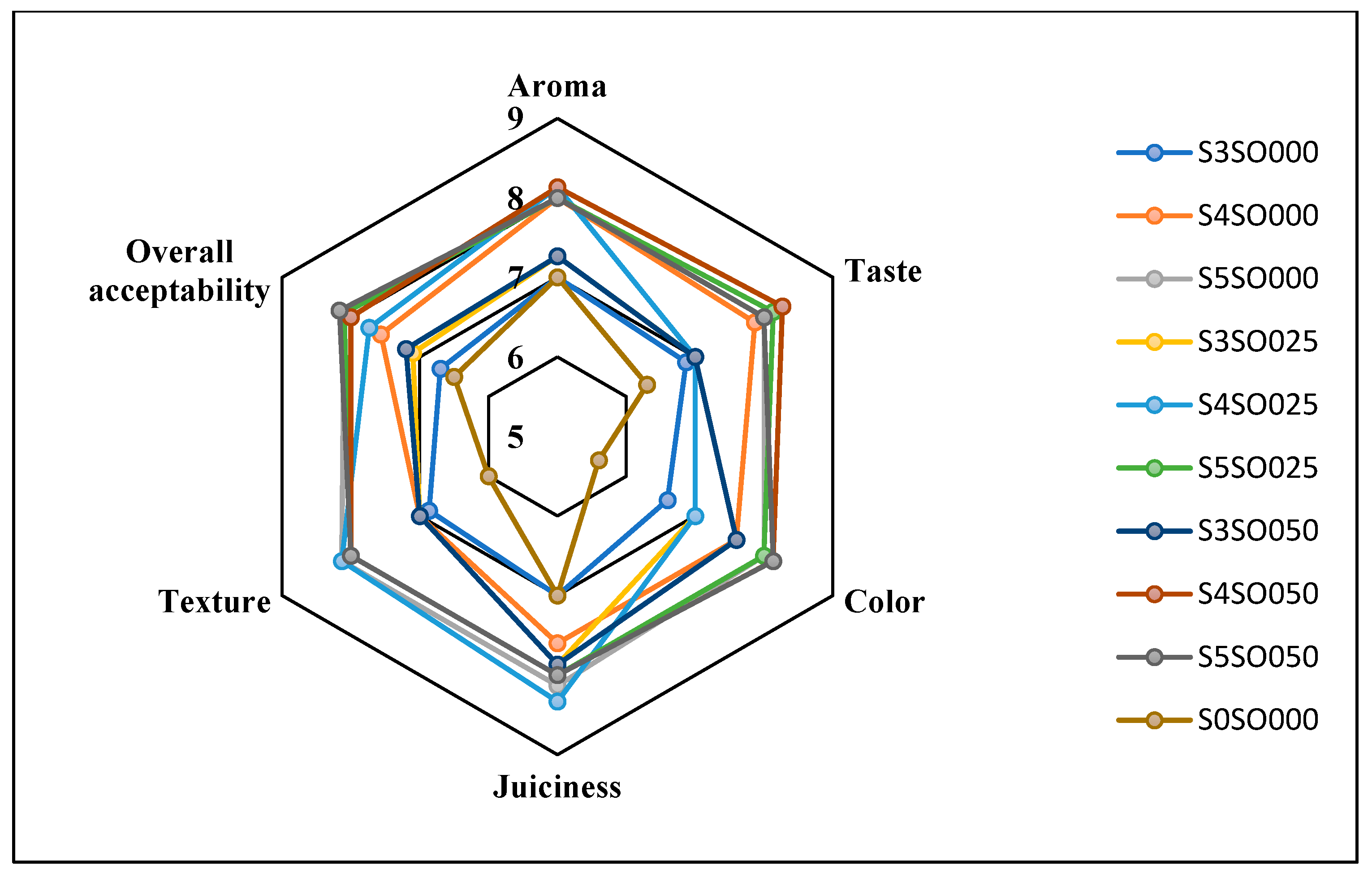
| Coating | Sago (%) | Soy Oil (%) | Lecithin (%) | Glycerol (%) |
|---|---|---|---|---|
| S3SO000 | 3.0 | 0.00 | 0.50 | 1.50 |
| S4SO000 | 4.0 | 0.00 | 0.50 | 1.50 |
| S5SO000 | 5.0 | 0.00 | 0.50 | 1.50 |
| S3SO025 | 3.0 | 0.25 | 0.50 | 1.50 |
| S4SO025 | 4.0 | 0.25 | 0.50 | 1.50 |
| S5SO025 | 5.0 | 0.25 | 0.50 | 1.50 |
| S3SO050 | 3.0 | 0.50 | 0.50 | 1.50 |
| S4SO050 | 4.0 | 0.50 | 0.50 | 1.50 |
| S5SO050 | 5.0 | 0.50 | 0.50 | 1.50 |
| S0SO000 | 0.0 | 0.00 | 0.00 | 0.00 |
| Parameter | Coating | Storage Days | |||
|---|---|---|---|---|---|
| 0th | 4th | 8th | 12th | ||
| pH | S3SO000 | 4.22 ± 0 | 4.44 ± 0.01 | 4.49 ± 0.02 | 4.66 ± 0.03 |
| S4SO000 | 4.22 ± 0 | 4.27 ± 0.01 | 4.65 ± 0.02 | 4.84 ± 0.03 | |
| S5SO000 | 4.22 ± 0 | 4.51 ± 0.01 | 4.88 ± 0.01 | 4.86 ± 0.03 | |
| S3SO025 | 4.22 ± 0 | 4.65 ± 0.01 | 4.66 ± 0.01 | 4.78 ± 0.02 | |
| S4SO025 | 4.23 ± 0 | 4.44 ± 0.05 | 4.46 ± 0.02 | 4.84 ± 0.03 | |
| S5SO025 | 4.22 ± 0 | 4.68 ± 0.01 | 4.73 ± 0.01 | 4.87 ± 0.01 | |
| S3SO050 | 4.22 ± 0 | 4.44 ± 0.01 | 4.58 ± 0.02 | 4.95 ± 0.02 | |
| S4SO050 | 4.22 ± 0 | 4.48 ± 0.01 | 4.67 ± 0.06 | 4.65 ± 0.01 | |
| S5SO050 | 4.22 ± 0 | 4.41 ± 0.02 | 4.64 ± 0.05 | 4.93 ± 0.04 | |
| S0SO000 | 4.22 ± 0 | 4.45 ± 0.01 | 4.46 ± 0.01 | 4.77 ± 0.03 | |
| TSS | S3SO000 | 11 ± 0 | 11 ± 0 | 11 ± 0 | 11 ± 0 |
| S4SO000 | 11 ± 0 | 11 ± 0 | 12 ± 0 | 13.33 ± 0.58 | |
| S5SO000 | 11 ± 0 | 11 ± 0 | 12 ± 0 | 12 ± 0 | |
| S3SO025 | 11 ± 0 | 11 ± 0 | 11.67 ± 0.58 | 13 ± 0 | |
| S4SO025 | 11 ± 0 | 11 ± 0 | 12.33 ± 0.58 | 13.33 ± 0.58 | |
| S5SO025 | 11 ± 0 | 11 ± 0 | 13 ± 0 | 14 ± 0 | |
| S3SO050 | 11 ± 0 | 12 ± 0 | 13 ± 0 | 14 ± 0 | |
| S4SO050 | 11 ± 0 | 11 ± 0 | 12 ± 0 | 14.33 ± 0.58 | |
| S5SO050 | 11 ± 0 | 11 ± 0 | 12 ± 0 | 13 ± 0 | |
| S0SO000 | 11 ± 0 | 10 ± 0 | 11 ± 0 | 11 ± 0 | |
| NEBI (Non-enzymatic Browning Index) | S3SO000 | 0.6 ± 0 | 0.84 ± 0.02 | 1.27 ± 0.04 | 1.81 ± 0.08 |
| S4SO000 | 0.6 ± 0 | 0.77 ± 0.04 | 1.25 ± 0.13 | 1.49 ± 0.02 | |
| S5SO000 | 0.6 ± 0 | 0.62 ± 0.03 | 1.26 ± 0.02 | 1.57 ± 0.08 | |
| S3SO025 | 0.6 ± 0 | 0.75 ± 0.02 | 1.18 ± 0.06 | 1.48 ± 0.05 | |
| S4SO025 | 0.6 ± 0 | 0.75 ± 0.00 | 1.38 ± 0.05 | 1.52 ± 0.01 | |
| S5SO025 | 0.6 ± 0 | 0.88 ± 0.03 | 1.08 ± 0.05 | 1.39 ± 0.05 | |
| S3SO050 | 0.6 ± 0 | 0.65 ± 0.02 | 1.06 ± 0.11 | 1.18 ± 0.05 | |
| S4SO050 | 0.6 ± 0 | 0.77 ± 0.02 | 0.95 ± 0.02 | 1.25 ± 0.08 | |
| S5SO050 | 0.6 ± 0 | 0.71 ± 0.01 | 1.08 ± 0.03 | 1.25 ± 0.07 | |
| S0SO000 | 0.6 ± 0 | 0.94 ± 0.03 | 1.39 ± 0.01 | 1.84 ± 0.04 | |
| Parameter | Coating | Storage Days | |||
|---|---|---|---|---|---|
| 0th | 4th | 8th | 12th | ||
| Moisture Content (%) | S3SO000 | 86.1 ± 0 | 86.00 ± 0.00 | 85.83 ± 0.29 | 85.83 ± 0.29 |
| S4SO000 | 86.1 ± 0 | 86.00 ± 0.00 | 85.83 ± 0.29 | 86 ± 0 | |
| S5SO000 | 86.1 ± 0 | 85.93 ± 0.12 | 86 ± 0 | 86 ± 0 | |
| S3SO025 | 86.1 ± 0 | 85.87 ± 0.12 | 86 ± 0 | 85.83 ± 0.29 | |
| S4SO025 | 86.1 ± 0 | 85.83 ± 0.29 | 86 ± 0 | 85.5 ± 0 | |
| S5SO025 | 86.1 ± 0 | 86.00 ± 0.00 | 85.83 ± 0.29 | 85.5 ± 0 | |
| S3SO050 | 86.1 ± 0 | 85.93 ± 0.12 | 86 ± 0 | 85.67 ± 0.58 | |
| S4SO050 | 86.1 ± 0 | 86.00 ± 0.00 | 85.87 ± 0.12 | 85.87 ± 0.12 | |
| S5SO050 | 86.1 ± 0 | 86.00 ± 0.00 | 86 ± 0 | 86 ± 0 | |
| S0SO000 | 86.1 ± 0 | 83.10 ± 0.17 | 82.33 ± 0.12 | 81.33 ± 0.29 | |
| Weight Loss (%) | S3SO000 | 0 ± 0 | 0.02 ± 0.02 | 0.11 ± 0.11 | 0.11 ± 0.02 |
| S4SO000 | 0 ± 0 | 0.04 ± 0.02 | 0.08 ± 0.03 | 0.09 ± 0.01 | |
| S5SO000 | 0 ± 0 | 0.02 ± 0.01 | 0.03 ± 0.01 | 0.08 ± 0.01 | |
| S3SO025 | 0 ± 0 | 0.03 ± 0.02 | 0.04 ± 0.02 | 0.09 ± 0.07 | |
| S4SO025 | 0 ± 0 | 0.04 ± 0.01 | 0.05 ± 0.02 | 0.13 ± 0.02 | |
| S5SO025 | 0 ± 0 | 0.01 ± 0.01 | 0.08 ± 0.04 | 0.11 ± 0.08 | |
| S3SO050 | 0 ± 0 | 0.05 ± 0.02 | 0.03 ± 0.02 | 0.23 ± 0.04 | |
| S4SO050 | 0 ± 0 | 0.04 ± 0.01 | 0.08 ± 0.06 | 0.15 ± 0.09 | |
| S5SO050 | 0 ± 0 | 0.02 ± 0.01 | 0.05 ± 0.02 | 0.09 ± 0.01 | |
| S0SO000 | 0 ± 0 | 0.09 ± 0.02 | 2.55 ± 0.41 | 3.18 ± 0.08 | |
| O2 concentration (%) | S3SO000 | 21 ± 0 | 20.87 ± 0.06 | 20.53 ± 0.23 | 20.27 ± 0.23 |
| S4SO000 | 21 ± 0 | 20.47 ± 0.29 | 20.27 ± 0.29 | 19.43 ± 0.64 | |
| S5SO000 | 21 ± 0 | 20.90 ± 0.05 | 19.90 ± 0.20 | 18.73 ± 0.06 | |
| S3SO025 | 21 ± 0 | 20.50 ± 0.17 | 20.55 ± 0.52 | 18.60 ± 0.35 | |
| S4SO025 | 21 ± 0 | 18.93 ± 0.06 | 19.37 ± 0.40 | 18.43 ± 0.06 | |
| S5SO025 | 21 ± 0 | 19.40 ± 0.05 | 19.07 ± 0.06 | 18.57 ± 0.06 | |
| S3SO050 | 21 ± 0 | 20.10 ± 0.10 | 19.93 ± 0.06 | 18.33 ± 0.12 | |
| S4SO050 | 21 ± 0 | 19.90 ± 0.52 | 19.83 ± 0.06 | 19.77 ± 0.12 | |
| S5SO050 | 21 ± 0 | 20.87 ± 0.06 | 19.77 ± 0.12 | 19.33 ± 0.23 | |
| S0SO000 | 21 ± 0 | 20.77 ± 0.12 | 18.77 ± 0.12 | 13.87 ± 0.06 | |
| CO2 concentration (%) | S3SO000 | 0.3 ± 0 | 1.10 ± 0.35 | 0.83 ± 0.06 | 2.8 ± 0.17 |
| S4SO000 | 0.3 ± 0 | 1.07 ± 0.23 | 0.83 ± 0.06 | 4.10 ± 0.15 | |
| S5SO000 | 0.3 ± 0 | 0.53 ± 0.06 | 1.27 ± 0.12 | 4.8 ± 0.17 | |
| S3SO025 | 0.3 ± 0 | 0.83 ± 0.12 | 2.77 ± 0.12 | 5.07 ± 0.4 | |
| S4SO025 | 0.3 ± 0 | 1.47 ± 0.29 | 3.03 ± 0.06 | 4.63 ± 0.06 | |
| S5SO025 | 0.3 ± 0 | 1.60 ± 0.35 | 3.20 ± 0.35 | 4.50 ± 0.52 | |
| S3SO050 | 0.3 ± 0 | 1.27 ± 0.06 | 2.27 ± 0.06 | 2.83 ± 0.06 | |
| S4SO050 | 0.3 ± 0 | 1.67 ± 0.23 | 2.30 ± 0.17 | 2.77 ± 0.12 | |
| S5SO050 | 0.3 ± 0 | 1.80 ± 0.20 | 2.33 ± 0.29 | 2.83 ± 0.29 | |
| S0SO000 | 0.3 ± 0 | 1.90 ± 0.35 | 2.77 ± 0.23 | 4.07 ± 0.23 | |
| Parameter | Coating | Storage Days | |||
|---|---|---|---|---|---|
| 0th | 4th | 8th | 12th | ||
| Browning Index | S3SO000 | 41.14 ± 0 | 74.63 ± 4 | 95.95 ± 8 | 75.34 ± 12 |
| S4SO000 | 41.14 ± 0 | 62.82 ± 9.1 | 65.8 ± 23.72 | 126.88 ± 2.03 | |
| S5SO000 | 41.14 ± 0 | 48.13 ± 4.17 | 70.7 ± 15.38 | 98.26 ± 20.48 | |
| S3SO025 | 41.14 ± 0 | 73.69 ± 6.38 | 79.66 ± 11.03 | 85.71 ± 4.59 | |
| S4SO025 | 41.14 ± 0 | 56.63 ± 3.23 | 73.62 ± 22.03 | 88.86 ± 12.05 | |
| S5SO025 | 41.14 ± 0 | 48.66 ± 13.89 | 82.02 ± 3.07 | 101.84 ± 5.85 | |
| S3SO050 | 41.14 ± 0 | 42.6 ± 5.52 | 61.12 ± 14.76 | 83.8 ± 12.56 | |
| S4SO050 | 41.14 ± 0 | 65.98 ± 2.53 | 74.23 ± 0.59 | 82.35 ± 1.6 | |
| S5SO050 | 41.14 ± 0 | 57.97 ± 11.59 | 65.38 ± 4.18 | 80.07 ± 19.37 | |
| S0SO000 | 41.14 ± 0 | 75.37 ± 18.27 | 84.47 ± 6.11 | 96.99 ± 5.19 | |
| Whiteness Index | S3SO000 | 62.86 ± 0 | 45.48 ± 4 | 43.3 ± 8 | 41.58 ± 12 |
| S4SO000 | 62.86 ± 0 | 54.85 ± 1.52 | 53.1 ± 3 | 36.05 ± 0 | |
| S5SO000 | 62.86 ± 0 | 62.23 ± 1.5 | 44.5 ± 3.35 | 38.19 ± 1.88 | |
| S3SO025 | 62.86 ± 0 | 49.57 ± 1.36 | 49.55 ± 1.41 | 37.84 ± 0.69 | |
| S4SO025 | 62.86 ± 0 | 54.86 ± 0.89 | 52.66 ± 2.95 | 39.48 ± 0.6 | |
| S5SO025 | 62.86 ± 0 | 53.45 ± 2.77 | 43.17 ± 0.67 | 34.94 ± 0.78 | |
| S3SO050 | 62.86 ± 0 | 62.97 ± 0.7 | 52.18 ± 1.35 | 44.83 ± 1.01 | |
| S4SO050 | 62.86 ± 0 | 53.29 ± 0.19 | 49.9 ± 0.32 | 48.85 ± 0.31 | |
| S5SO050 | 62.86 ± 0 | 54.88 ± 2.83 | 52.58 ± 0.31 | 43.4 ± 3.64 | |
| S0SO000 | 62.86 ± 0 | 49.15 ± 4.62 | 42.96 ± 0.82 | 37.54 ± 0.48 | |
| Microbial Analysis | S3SO000 | 0 ± 0. | 0.67 ± 0.02 | 1.73 ± 0.07 | 3.98 ± 0.01 |
| S4SO000 | 0 ± 0 | 0.64 ± 0.01 | 1.5 ± 0.01 | 3.85 ± 0.01 | |
| S5SO000 | 0 ± 0 | 0.41 ± 0.01 | 1.14 ± 0.01 | 3.56 ± 0 | |
| S3SO025 | 0 ± 0 | 0.21 ± 0.01 | 0.39 ± 0.53 | 3.04 ± 0.01 | |
| S4SO025 | 0 ± 0 | 0.28 ± 0 | 1.11 ± 0.01 | 3.25 ± 0 | |
| S5SO025 | 0 ± 0 | 0.31 ± 0 | 1.1 ± 0 | 3.28 ± 0 | |
| S3SO050 | 0 ± 0 | 0.24 ± 0.05 | 1.09 ± 0.01 | 3.24 ± 0.02 | |
| S4SO050 | 0 ± 0 | 0.21 ± 0.01 | 0.39 ± 0.53 | 3.04 ± 0 | |
| S5SO050 | 0 ± 0 | 0.25 ± 0 | 1.07 ± 0.06 | 3.08 ± 0 | |
| S0SO000 | 0.4 ± 0 | 1.08 ± 0.07 | 1.81 ± 0.01 | 4.48 ± 0.07 | |
Disclaimer/Publisher’s Note: The statements, opinions and data contained in all publications are solely those of the individual author(s) and contributor(s) and not of MDPI and/or the editor(s). MDPI and/or the editor(s) disclaim responsibility for any injury to people or property resulting from any ideas, methods, instructions or products referred to in the content. |
© 2024 by the authors. Licensee MDPI, Basel, Switzerland. This article is an open access article distributed under the terms and conditions of the Creative Commons Attribution (CC BY) license (https://creativecommons.org/licenses/by/4.0/).
Share and Cite
Zhang, M.; Xiao, D.; Zhu, C.; Younis, K.; Yousuf, O. Shelf-Life Extension and Quality Changes of Fresh-Cut Apple via Sago and Soy-Oil-Based Edible Coatings. Coatings 2024, 14, 1202. https://doi.org/10.3390/coatings14091202
Zhang M, Xiao D, Zhu C, Younis K, Yousuf O. Shelf-Life Extension and Quality Changes of Fresh-Cut Apple via Sago and Soy-Oil-Based Edible Coatings. Coatings. 2024; 14(9):1202. https://doi.org/10.3390/coatings14091202
Chicago/Turabian StyleZhang, Manmin, Di Xiao, Congfei Zhu, Kaiser Younis, and Owais Yousuf. 2024. "Shelf-Life Extension and Quality Changes of Fresh-Cut Apple via Sago and Soy-Oil-Based Edible Coatings" Coatings 14, no. 9: 1202. https://doi.org/10.3390/coatings14091202
APA StyleZhang, M., Xiao, D., Zhu, C., Younis, K., & Yousuf, O. (2024). Shelf-Life Extension and Quality Changes of Fresh-Cut Apple via Sago and Soy-Oil-Based Edible Coatings. Coatings, 14(9), 1202. https://doi.org/10.3390/coatings14091202






